KINGSTON HISTORY: The ROME RAILROAD “Y”
by Larry Posey © 2025
This article was originally published in 2016 as part of an Etowah Valley Historical Society event celebrating the 150th Anniversary of the Civil War in Bartow County. It is not a historical document, instead it is a narrative of events taking place in Kingston’s Rome Railroad “Y.” For a more complete historical account of these occasions, the reader is encouraged to access the publications listed in the Reference Section at the end of this article.
Travelling from Cartersville on Hwy 293 and upon entering the city limits of the bucolic and rural village of Kingston, visitors are greeted by an attractive “Welcome to Historic Kingston” banner. After touring the town, visitors new to the area often ask “Where is the history?” Indeed, one must mix a robust imagination with historical facts and folklore to appreciate the unfolding of long-ago events that took place in this small town. One site worth experiencing is an approximate four-acre parcel referred to as the Rome Railroad “Y” (or “WYE” using proper railroad terminology of that time). The “Y” is clearly discernible in an aerial view of the town.

The original city limits of Kingston outline a circular area with a radius of one-half mile measured from the Western and Atlantic Railroad (W&A RR) Depot that marked the town’s center. Georgia funded the W&A RR survey, property acquisition, and construction of the railroad that ran from Atlanta to Chattanooga. The Kingston section was completed around 1844 several years after the Cherokee Nation was removed to Oklahoma.
A large flat area within the city limits caught the eye of businessmen in Rome and Floyd County. Realizing the economic potential of a railroad connecting Rome to the W&A RR at Kingston, they formed the Memphis Branch Railroad who built a 20-mile railroad from Rome to Kingston and connected it to an approximate four-acre rail yard in the Kingston city limits. The Rome Railroad opened for business around 1849 connecting Coosa Valley commerce with that of Chattanooga and Atlanta.
The “Y” area can be seen from the downtown business district when looking diagonally south-west across the present-day CSX Railroad. Or, if you happen to be at the Kingston Museum, look west across the ball field. There you will see an approximate four-acre level area inside of which are the weathered remnants of old curving roadbeds upon which once lay iron rails used by the former Rome Railroad. This area is referred to as the Rome Railroad “Y.”
Several surviving railroad artifacts of those historic days can still be seen. One building, affectionately called the 1854 Rome Railroad Station Master’s House, still stands adjacent to the abandoned rail bed in the “Y.” Close by are two concrete columns marking the entrance to the “Y” from Rome.
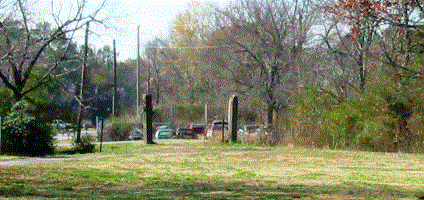
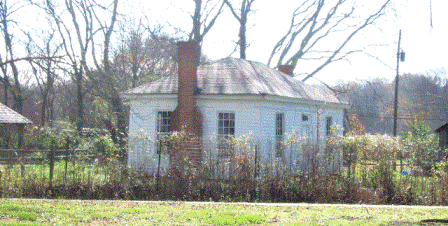
It is challenging to appreciate the drama and back breaking toil that occurred on this piece of real estate during the mid-nineteenth century. Imagine this part of Kingston’s history told from the viewpoint of those living at the time. Visualize yourself in 1849 standing in a tree-barren level field congested with men, construction equipment, and materials necessary for transforming the area into a railroad “Y”. You observe rugged men building a complicated rail system connecting the railroad running from Rome along the northern banks of the Etowah River to the newly constructed Western and Atlantic Railroad (W&A) running from Atlanta to Chattanooga. The “Y” configuration is designed to enable trains coming from Rome to access the W&A Railroad’s main line and turn around for return to Rome without having to use an expensive turnstile.
Another group of workers outside the “Y” has extended the W&A RR main line beyond Kingston north toward Adairsville and on to Chattanooga. It is a noisy scene. Crew bosses are shouting orders and wagon masters are yelling commands and cracking whips to keep their teams on task. The clanging beat of workmen driving spikes to fasten rails onto roadbed crossties creates rhythms and tones that are almost musical.
Within a few months’ time, man-made structures begin to emerge from the tree-barren level field. A train depot constructed of limestone blocks sits on the south side of the main line with yard/side tracks running alongside it. The Kingston Depot is identical to one built at Cass Station.  It has been removed and exists only in old photos. Additional tracks provide Rome Railroad easement to the W&A RR mainline by means of a series of switches. One set of tracks on the east side of the depot provides easy access to Atlanta. The second set gives access to Chattanooga on the western side. Both sets curve back toward Rome connecting with the Rome Railroad main line just beyond the 1854 Rome Station Masters House.
It has been removed and exists only in old photos. Additional tracks provide Rome Railroad easement to the W&A RR mainline by means of a series of switches. One set of tracks on the east side of the depot provides easy access to Atlanta. The second set gives access to Chattanooga on the western side. Both sets curve back toward Rome connecting with the Rome Railroad main line just beyond the 1854 Rome Station Masters House.
Your thoughtful reflection on the construction activities is interrupted by an imaginary passerby telling you that around 100 people live in the village and asks you if you are looking for work. Construction foremen are hard pressed for laborers. Some families with names like Martin and Vincent reflect migrations to Kingston from Huguenot communities in South Carolina. Quickly jump six years later to 1852. If you made your home here during that time, you would have joined a population that has increased to 1,169 residents. Within a short period of time, you witness a surge in home, business, and warehouse construction creating demand for more laborers to operate the Rome Railroad “Y” switching yard; to maintain local sections of the rail lines; and to cope with increased commercial functions associated with handling agricultural and manufactured goods. Kingston is turning out to be a vibrant town.
Now picture yourself 10 years later to April 12, 1862 (nearly one year after the beginning of the Civil War). The streets in the business section of town that lay across the rail lines north of the depot are muddy from an early morning spring rain. Store merchants are washing down their wooden sidewalks. One store owner is cursing the local rounder who, after imbibing at several of the many saloons, likes to show off by riding his horse on the sidewalks breaking a few boards and leaving evidence of horse traffic along the way. The normal morning calm is broken by unexpected sounds of shrill train and caboose whistles, clanging bells, and puffing steam engines causing residents to turn their attention to an unusual amount of train traffic for this time of morning.
A freight train named the New York just pulled into Kingston from Chattanooga and stopped on the main line near the depot. A Rome Railroad mail train named the William R. Smith is parked on one of the Rome rail lines near the depot. It maintains a full head of steam on the engine. The crew begins to prepare their breakfast meal. Shortly later, another train, the General, announces its arrival on the main line coming from Kennesaw. It has braked to a slow crawl, seeing that the New York was also on the main line blocking any further movement past the depot. Uriah Stevens, the Station Agent, allows the New York to remain on the main line and orders the General to move forward on a side track and park placing the engine near the switch to the W&A RR main line on the west end of the “Y.” 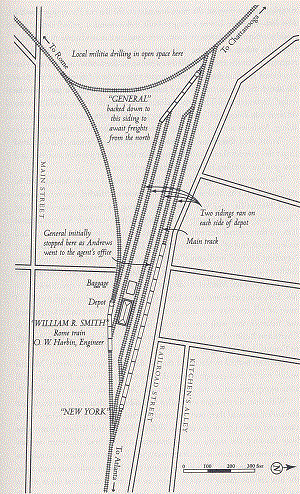 By this time, a curious crowd has gathered on the street in the business area across from the depot deliberating about the events unfolding before their eyes. “Who is that tall feller climbing down from the General’s engine?” asked one person. “He looks like a politician dressed in that long overcoat,” answered another. “It sure ain’t Fuller and his crew, and it ain’t no passenger train, just look at the number of freight cars,” exclaimed another spectator. “Here comes Uriah. Maybe he can tell us what’s going on over there,” another of the group exclaimed.
By this time, a curious crowd has gathered on the street in the business area across from the depot deliberating about the events unfolding before their eyes. “Who is that tall feller climbing down from the General’s engine?” asked one person. “He looks like a politician dressed in that long overcoat,” answered another. “It sure ain’t Fuller and his crew, and it ain’t no passenger train, just look at the number of freight cars,” exclaimed another spectator. “Here comes Uriah. Maybe he can tell us what’s going on over there,” another of the group exclaimed.
According to Uriah Stevens, the depot has lost telegraph service all the way to Atlanta and nobody knows why that tall stranger instead of Fuller was on the General. We know that a big battle is going on around Chattanooga and that the New York and other trains are evacuating supplies out of Chattanooga for fear of their being captured by the Yankees. The well-dressed sharp talking man said his name was Andrews and that he had been ordered to transport a load of ammunition to General Beauregard in Corinth by way of Chattanooga. Because of lost telegraph communication, no one could confirm Andrew’s story. “Boys,” drawled Uriah, “I am awfully suspicious and have ordered the switch tender not to let the General back onto the main W&A RR line.”
Despite Andrews’ vigorous protests, Uriah Stevens managed to delay the General in Kingston at least an hour when another freight train from Chattanooga pulled into Kingston – the caboose clearing the switch on the west entrance to the W&A RR main line where the General’s engine was parked. As the newly arrived train came to a complete stop, spectators looked on in amazement as Andrews sprang into action. He forcefully grabbed the switch key, opened the switch, and cleared the way for the General to reenter the main line to Chattanooga. The Yanks hiding in the cargo cars were on their way.
As the General pulled away from Kingston toward Adairsville, another engine, the Yonah, roared into town from the direction of Marietta. Also finding the main line blocked by the freight trains arriving from Chattanooga, the Yonah pulled to a stop and a young man jumped out of the cab yelling and running to a group milling around Uriah Stevens and the switch tender. After several minutes of animated conversation, the young man ran over to the Rome mail train (the William R. Smith). More animated conversation took place and suddenly the train crew and the young man jumped aboard the Rome mail train and with a full head of steam immediately chased after the General.
A local militiaman whose unit had been drilling in a field west of the “Y” joined the locals who were observing and trying to make sense of all the commotion. “Boys, the Yankees have just invaded Kingston,” exclaimed the militiaman who prided himself on being knowledgeable of military operations. He speculated, “Those freight cars pulled by the General was full of Yankee soldiers. They stole the train at Big Shanty. They’ve been tearing up train tracks and telegraph lines. Bill Fuller is the man who was on the Yonah and had ‘bout run his legs off’ trying to catch up with his train that they stole. Lord knows what no good those Yankees are up to. Maybe Fuller and that mail train can stop them before they cause any more harm.” Indeed, Fuller did catch up with the General two miles north of Ringold (albeit using another train, the Texas that was on a side switch near Adairsville) resulting in Andrews and his men scattering into the countryside where they were later captured.
The bizarre events occurring on that day remained the talk of the town for the next two years. Although Kingston had been spared so far from the destructive effects of battle, it felt the war’s impact in other ways. Kingston became a stopover point for soldiers travelling between Rome, and Atlanta and the Chattanooga battlefields. Trains seldom ran at night because of potential road hazards and travelers (many whom were wounded soldiers) were forced to stay overnight in Kingston. The patriotic ladies in Kingston attended to the soldiers’ needs for rest, shelter and medical care.
Fast forward in time another two years. At four o’clock on Wednesday morning of May 18, 1864, barking dogs announce the arrival of an army approaching the town. Confederate troops belonging to Hardee’s Corps are marching in a thick fog down Hall Station Road from Adairsville through Kingston toward Cassville. They are a grimy bunch with smutty faces and uniforms from smoke of many camp fires along the route. Although exhausted, they are in a jovial mood singing and boasting to weary-eyed residents who braved the early morning chill to greet their Southern boys. The marching soldiers vowed to stop Sherman and return victorious within the week.
Federal troops arrived in Kingston the next day on the heels of Hardee’s Corps who had just crossed Two Run Creek east of town on the old Cassville Road. The roar of artillery echoed across the town as the Federals fired parting shots from the intersection of Main Street and Hardin Bridge Road toward the retreating Confederates. After Federal scouts and Cavalry reported that Kingston was free of Confederate forces, Sherman’s army began setting up headquarters for a three-day stand down.
Sherman ordered his Headquarters of the Military Division of the Mississippi to be set up in Kingston. The Rome Railroad’s 1854 Station Master’s House was requisitioned for that purpose. Here military orders and dispatches are received and transmitted from this newly painted white wooden structure that stands out among Kingston’s drab and war-weary residences. Sherman also used forward command posts closer to military operations during the Battle of Atlanta.
Most of the units comprising his Army of the Tennessee set up camp near Kingston and in the surrounding areas of Bartow County. Numerous buildings and residences in the vicinity of the “Y”, are occupied by staff elements responsible for planning successive military operations such as Sherman’s March to the Sea and his Carolina Campaign.
Barely five months have gone by since the Federals began their occupation of Kingston. It has been a troublesome time for Kingston residents. They have lost their freedom of movement among other inconveniences. Adding to the misery, residents woke to another rainy and soggy day on October 3rd, 1864. Rain has been coming down for several days and the road crews are complaining about the Federal Army’s strict orders to take measures preventing wet weather from undermining the Rome railroad beds. They are unaware that Sherman had sent a dispatch to General Corse at Rome to move his entire division by rail from Rome to Kingston and switching to the W&A RR for movement to Allatoona Pass to reinforce a Federal fort that was facing an imminent attack by Confederate General Hood. The Federals had been using the Allatoona Pass as a staging area for provisions and ammunition transported by rail from Chattanooga to Sherman’s army battling for control of Atlanta. Hood’s objective was to cut Sherman’s Chattanooga supply line to Atlanta at the Allatoona Pass.
The next day, disgruntled railroad crews were dispatched to repair a section of undermined road bed between Kingston and Rome that had caused derailment of at least 15 cars requested by General Corse. After the repair, an engine carefully pulled 20 cars into Rome – enough for only one brigade of 1,054 soldiers. Ignoring the potential hazards of travelling by rail at night, the train left Rome at around 8:30pm on October 4th and arrived at the Allatoona Pass garrison at 1:00am on October 5th, barely five and one-half hours before the Confederate bombardment of the garrison began at 6:30am. Fortunately for the Federals, the Rome RR “Y” in Kingston facilitated the movement of troops and equipment from Rome to Allatoona in a matter of hours that otherwise would have taken over a day of forced marching. The time saved allowed General Corse to improve the defenses of the lightly entrenched position at Allatoona and defeat the attacking Confederate forces.
A month has passed since elements of General Corse’s Division moved through Kingston. It is a cool and clear day on Wednesday, November 9th, 1864. Atlanta has fallen into the hands of Sherman’s Army. The Confederate Army is marching toward Savannah, Georgia with the Federals in pursuit. There is much excitement and activity in Kingston. Buildings occupied by Sherman’s headquarters’ staff are being evacuated; tents are struck and stowed in wagons parked throughout the town.
 Cameramen are busy taking pictures to record this site of momentous events. This is a view of Kingston Rail Yards in November 1864 looking south toward Atlanta. Images of mules hitched to supply wagons and artillery teams near a two-story hotel building are depicted as restless in their traces and eager to move. At least two engines are shown with steam and smoke billowing from their stacks and pulling loaded cars toward Atlanta. The white building on the right is the 1854 Station Master’s House. It clearly stands out among all other surrounding buildings. It is the only building painted white signaling to message bearers that this is one of Sherman’s headquarters. A U.S. Army tent or wagon is positioned next to it. Serving as a command post, it would be the last headquarters’ building to close before Sherman begins his “March to the Sea.”
Cameramen are busy taking pictures to record this site of momentous events. This is a view of Kingston Rail Yards in November 1864 looking south toward Atlanta. Images of mules hitched to supply wagons and artillery teams near a two-story hotel building are depicted as restless in their traces and eager to move. At least two engines are shown with steam and smoke billowing from their stacks and pulling loaded cars toward Atlanta. The white building on the right is the 1854 Station Master’s House. It clearly stands out among all other surrounding buildings. It is the only building painted white signaling to message bearers that this is one of Sherman’s headquarters. A U.S. Army tent or wagon is positioned next to it. Serving as a command post, it would be the last headquarters’ building to close before Sherman begins his “March to the Sea.”
General Sherman, in “Special Field Orders Number 129 issued by the Headquarters, Military Division of the Mississippi, in the Field at Kingston, Georgia, dated November 9, 1864” describes the mission and operational authority given to Sherman’s four Army Corps in their infamous “March to the Sea.” It is the last of Sherman’s dispatches from Kingston. Local folklore surmises that the orders were dispatched and telegraphed from the Rome RR 1854 Station Masters’ House.
Christmas came and went and finally the war ended. Kingston was occupied a second time by Federal troops. This time the guns are silent and soldiers are seen working alongside civilian laborers in the Railroad “Y.” They are busy distributing relief supplies to refugees and transporting displaced persons and residents in Northwest Georgia left destitute by the ravages of war.
Although the train depot built by the W&A RR survived the war, it took a natural disaster to bring it down. Early Monday morning on December 12, 1892, a fire of unknown origin destroyed the structure. The intense heat caused walls made of limestone blocks to crumble. The wooden desks, telegraph tables and safe were destroyed. Most of the records and freight, however, were saved. A wooden depot was built to replace it. 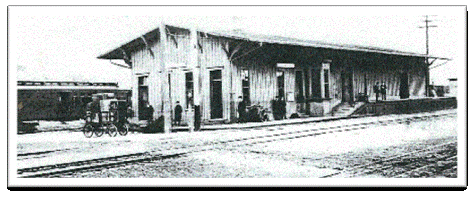 Ironically this depot burned in July 1974. Broken concrete surrounding a depression in the ground marks the spot where these depots once stood.
Ironically this depot burned in July 1974. Broken concrete surrounding a depression in the ground marks the spot where these depots once stood.
The Nashville, Chattanooga and St. Louis Railway (NC&StL) acquired the Rome Railroad (including the Kingston “Y”) on December 31, 1896. The deed is recorded on January 8, 1897 in deed book “CCC,” page 96, in the Office of the Superior Court Clerk of Floyd County, Georgia.
Economic changes occurring in the early 1900’s and continuing through the 1940’s adversely impacted the NC&StL (a.k.a. Rome Railroad) and its “Y” easement to the old W&A RR in Kingston. The construction of additional railroads through Rome and the improvement of road networks in northwest Georgia created new avenues for the shipment of commercial goods. The “Y” had become less important to NC&StL as a trans-shipment center resulting in passenger service being its main source of revenue.
On Friday, January 15, 1943, a Federal Interstate Commerce Commission hearing conducted by a Mr. Swiggart was held in Rome, Georgia on an application of the Nashville, Chattanooga and St. Louis Railway for permission to abandon its Rome Branch railway right of way extending from Rome to Kingston along the Etowah River reserving the “Y” parcel as a railroad maintenance and staging area. The hearing lasted all day and included numerous witnesses and petitions. The questioning became testy at times as illustrated by the following excerpt:
Q. (Mr. Swiggart) Describe your train movement between Rome and Kingston.
A. (Mr. Burke) It is a mixed train.
Q. (Mr. Swiggart) Is it one engine and one freight car and one passenger car, or how many?
A. (Mr. Burke) My recollection is that the passenger car is –
Q. (Mr. Swiggart) You do not know what it is, do you, Mr. Burke?
A. (Mr. Burke) No sir.
Q. (Mr. Swiggart) If you do not know, just say so.
A. (Mr. Burke) No, I do not know.
NOTE: A copy of the hearing minutes is on file in the Kingston Museum.
The Commission’s approval of the NC&StL RR application sealed the fate of those nostalgic train rides to Rome along the scenic Etowah River in passenger cars furnished with wine velvet seats, kerosene lamps and pot-bellied stoves. The old rail road beds are visible in many places as well as collapsed bridges over stream beds along the route.
After WWII and with the introduction of mechanical railway maintenance equipment in the 1950’s, the area of the Railroad “Y” property became less important as a staging area. The remaining section houses and maintenance structures were removed from the approximate four-acre “Y” parcel leaving a barren field. Rail switches to the old W&A RR were disconnected.
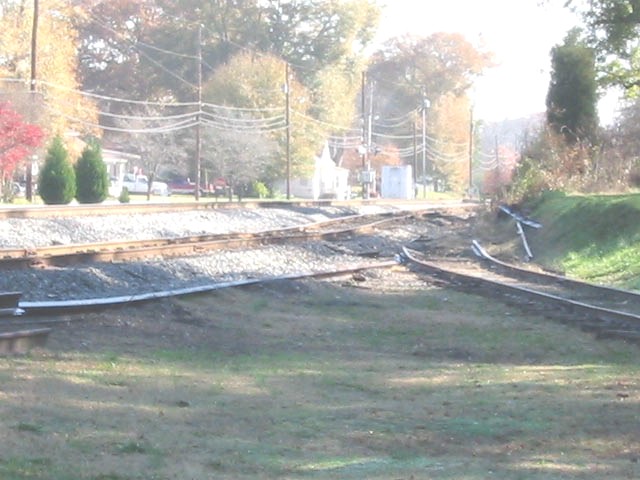
On April 8, 2004 the State Properties Commission granted the City of Kingston a Quit Claim Deed to the property for the purpose of Kingston building a park to house a monument honoring America’s War Veterans. The City of Kingston has been using the area for passive recreation.
The “Y” area is one of the last visible examples of Kingston’s early railroad history. It will become a lost memory without due vigilance and protection. As the saying goes, “If you forget your past, you will have no future worth remembering.”
**********
NOTES:
A 137-mile rail line was constructed between Atlanta and Chattanooga in 1841–50 by the State of Georgia at a cost of almost five million dollars. It reached Kingston in 1845. It was called the Western and Atlantic Rail Road (W&A RR). The right of way is still owned by the State of Georgia but leased to CSX Transportation.
About the same time, the Rome Railroad Company chartered in 1839 as the Memphis Branch Railroad and Steamboat Company, built a 20-mile line from Rome to Kingston in 1848-49 for the purpose of acquiring easement to the W&A RR main line. Easement was made with the construction of a “Y” rail bed configuration on an approximate four-acre parcel in the City of Kingston during this time frame.
In 1890, the State of Georgia leased the W&A RR right-of-way to NC&StL Railroad Company.
Six years later on December 31, 1896, the NC&StL Railroad Company acquired the Rome Railroad Company. The deed was recorded on January 8, 1897 in deed book “CCC,” page 96, in the Office of the Superior Court Clerk of Floyd County, Georgia.
Years later in 1943, the NC&StL Railroad Company made application to the Federal Interstate Commerce Commission to cease operations of their Rome Railroad holdings resulting in the abandonment of the 20-mile rail line right of way running from Rome to Kingston. Further deed research is needed as to disposition of the 4-acre parcel known as the Rome RR “Y” and its easement to Georgia’s W&A RR right-of-way.
In May 1996, the State of Georgia Properties Commission transferred the NC&StL Railroad Company’s lease of the W&A RR right of way to CSX Transportation. The current CSX lease, including the “Y” parcel in Kingston, expires in 2070.
Although this article was written as a narrative, several interesting historical publications about railroads associated with the Rome Railroad’s operation within the Kingston City Limits are listed below.
REFERENCES
Bonds, Russel S. (2007), Stealing the General: The Great Locomotive Chase and the First Medal of Honor. Yardley, Pennsylvania: Westholme Publishing, LLC.
Cunyus, Lucy J. (1989). History of Bartow County, Georgia Formerly Cass. Easley, SC: Southern Historical Press, Inc.
Head, Joe F. (1997). The General: The Great Locomotive Dispute. Cartersville, GA: Bartow History Center.
Howard, F. (1905). In and Out of the Lines. New York: The Neal Publishing Company. (Reprinted copies can be purchased from the Etowah Valley Historical Society.)
Mulinix, Martha H. (1992). We Remember Kingston . . . Woman’s History Club & Others, Marietta: Marietta Quick Copy Center, Inc. (Reprinted copies can be purchased from the Etowah Valley Historical Society.)
Scaife, William R. (1995). Allatoona Pass: A Needless Effusion of Blood. (Private printing. (Copies can be purchased from the Etowah Valley Historical Society.)
Transcript of Stenographer’s Minutes before the Interstate Commerce Commission, Finance Document 14017, application of the Nashville, Chattanooga and St. Louis Railway for permission to abandon its Rome Branch extending from Kingston to Rome, Georgia, January 15, 1943. (A copy is on file in the Kingston Museum.)
The Courant American, (December 15, 1992) Cartersville, GA. (Microfilm copy is on file with the Etowah Valley Historical Society.)
